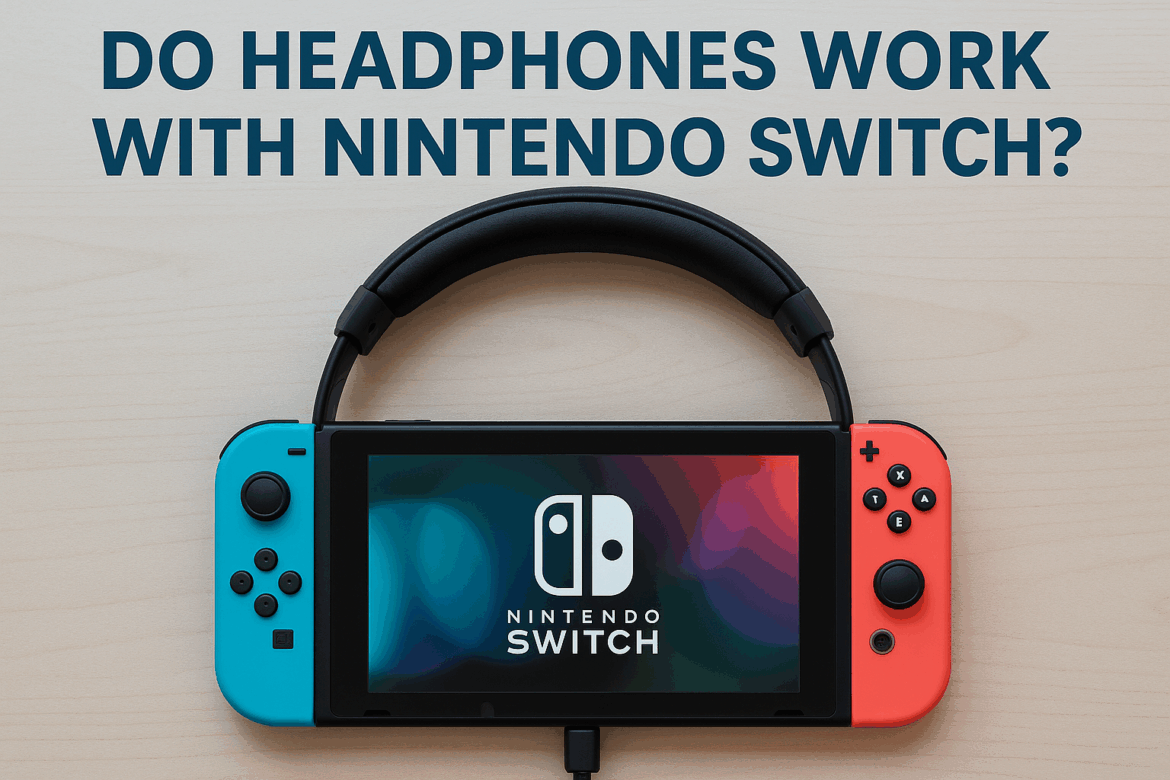Tun Kopfhörer Arbeiten mit der Nintendo Switch? Ein umfassender Leitfaden
Als erfahrener Technikjournalist und leidenschaftlicher Gamer habe ich mich oft mit den Feinheiten der Geräte beschäftigt, die das Rückgrat unseres digitalen Lebens bilden. Die Nintendo Switch nimmt dabei eine besondere Stellung ein. Ihre Vielseitigkeit als Heimkonsole und Handheld ist unübertroffen, doch beim Thema Sound stehen viele vor einem Rätsel. Funktionieren Kopfhörer mit der Nintendo Switch? Spoiler-Alarm: Ja, sie funktionieren. Aber wie bei allen technischen Dingen steckt der Teufel im Detail. In diesem Artikel gehen wir genauer auf die Verwendung von Kopfhörern mit der Nintendo Switch ein und beleuchten kabelgebundene und kabellose Optionen, Kompatibilitätsprobleme und mehr.
Grundlagen verstehen: Kabelgebundene Kopfhörer an der Nintendo Switch
Am einfachsten schließen Sie Kopfhörer an Ihre Nintendo Switch an, indem Sie die 3,5-mm-Klinkenbuchse an der Oberseite der Konsole verwenden. Diese Buchse unterstützt alle gängigen kabelgebundenen Kopfhörer, sodass Sie Ihre Lieblingskopfhörer problemlos anschließen und in die faszinierende Welt von Hyrule oder die rasanten Strecken von Mario Kart eintauchen können. Beachten Sie jedoch, dass diese Verbindung zwar die Audioausgabe ermöglicht, aber keinen Mikrofoneingang unterstützt. Wenn Sie also während des Spielens per Voice-Chat kommunizieren möchten, müssen Sie andere Möglichkeiten in Betracht ziehen.
Kabellose Kopfhörer: Ein Wendepunkt?
Kabellose Kopfhörer erfreuen sich immer größerer Beliebtheit – und das aus gutem Grund. Sie bieten Freiheit von Kabelsalat und maximale Bewegungsfreiheit. Doch wie schlagen sie sich mit der Nintendo Switch? Anfangs unterstützte die Switch kein Bluetooth-Audio, sehr zum Leidwesen von Fans kabelloser Kopfhörer. Ein Update Ende 2021 änderte dies jedoch grundlegend. Die Switch unterstützt nun Bluetooth-Audioausgabe, allerdings mit einigen Einschränkungen.
Bluetooth-Audio: Was Sie wissen müssen
Die Bluetooth-Unterstützung ist zwar eine willkommene Neuerung, bringt aber auch Einschränkungen mit sich. So können Bluetooth-Kopfhörer beispielsweise nur dann mit der Switch verbunden werden, wenn maximal zwei kabellose Controller aktiv sind. Das bedeutet, dass man bei geplanten Multiplayer-Partien gegebenenfalls auf kabelgebundene Kopfhörer zurückgreifen oder den Ton mit anderen Spielern teilen muss. Zudem kann es zu einer leichten Audioverzögerung kommen, was für manche ambitionierte Spieler, die auf blitzschnelle Audiosignale angewiesen sind, ein Ausschlusskriterium sein kann.
Verwendung von USB-Kopfhörern mit Nintendo Switch
USB-Kopfhörer sind eine weitere praktikable Option für Switch-Nutzer, insbesondere wenn die Konsole angedockt ist. Durch Anschließen der USB-Kopfhörer an den USB-Anschluss der Dockingstation genießen Sie ein nahtloses Audioerlebnis ohne Adapter. Diese Option ist jedoch nur im Dock-Modus verfügbar, was ihre Flexibilität etwas einschränkt.
Die Rolle der Adapter: Die Lücke schließen
Für Technikbegeisterte können Adapter Gold wert sein. Die Nintendo Switch unterstützt verschiedene Audioadapter, sodass Spieler kabellose Kopfhörer über einen USB-C- oder 3,5-mm-Adapter verwenden können. Diese Adapter umgehen die Einschränkungen von Bluetooth und bieten eine stabilere und vielseitigere Audioverbindung. Die Wahl des richtigen Adapters kann jedoch knifflig sein, und es ist wichtig, die Kompatibilität mit dem jeweiligen Kopfhörermodell sicherzustellen.
Ein kurzer Vergleich: Kabelgebunden vs. Kabellos
Um die Vor- und Nachteile der einzelnen Optionen besser zu verstehen, werfen wir einen Blick auf die folgende Tabelle:
| Merkmal | Kabelgebundene Kopfhörer | Kabellose Kopfhörer |
|---|---|---|
| Benutzerfreundlichkeit | Einfaches Plug-and-Play | Kopplung erforderlich |
| Mobilität | Begrenzt durch Kabellänge | Bietet volle Mobilität |
| Latenzzeit | Keine | Mögliche Verzögerung |
| Kompatibilität | Universalstecker mit 3,5-mm-Klinkenbuchse | Erfordert Bluetooth-Unterstützung |
| Mikrofonunterstützung | Nein | Begrenzt, je nach Modell |
| Flexibilität im Mehrspielermodus | Volle Unterstützung | Beschränkt auf zwei Controller |
Umgang mit häufigen Problemen und Lösungsansätzen
Trotz der Fortschritte kann es bei der Verbindung von Kopfhörern mit der Switch zu Problemen kommen. Ein häufiges Problem ist die instabile Bluetooth-Verbindung. Eine einfache Lösung ist, sicherzustellen, dass die Kopfhörer vollständig aufgeladen sind und die neueste Firmware installiert haben. Ein weiteres häufiges Problem ist die fehlende Mikrofonunterstützung bei kabelgebundenen Verbindungen. Dies lässt sich jedoch umgehen, indem man eine separate Sprachchat-App auf dem Smartphone oder Tablet verwendet.
Persönliche Anekdoten: Eine Klangreise
Meine persönlichen Erfahrungen mit Kopfhörern an der Nintendo Switch sind sehr unterschiedlich und hängen stark von der jeweiligen Situation ab. Ich erinnere mich an eine Reise durch Europa, als ich mit meiner Switch in der Hand die lange Zugfahrt vertreiben wollte. Meine treuen kabelgebundenen Kopfhörer lieferten eine makellose Klangqualität und versetzten mich mitten in die majestätischen Landschaften von Breath of the Wild. Ganz anders verhielt es sich bei einem kürzlichen Splatoon 2-Marathon mit Freunden: Mein kabelloses Headset war durchwachsen – die Bewegungsfreiheit war zwar fantastisch, aber die gelegentlichen Audioverzögerungen waren alles andere als optimal.
Fazit: Finden Sie Ihren perfekten Partner
Letztendlich hängt die Wahl zwischen kabelgebundenen und kabellosen Kopfhörern für Ihre Nintendo Switch von Ihren persönlichen Vorlieben und Spielgewohnheiten ab. Kabelgebundene Kopfhörer sind eine zuverlässige Wahl für Einzelspieler und bieten beste Audioqualität ohne Latenz. Kabellose Kopfhörer hingegen bieten unvergleichliche Bewegungsfreiheit, allerdings mit einigen Kompromissen in puncto Verbindung und Latenz.
Wer etwas Zeit und Geld investieren möchte, kann mit einem hochwertigen Adapter und einem erstklassigen Kopfhörer das Beste aus beiden Welten genießen. Wie bei vielen technischen Entscheidungen geht es darum, die richtige Balance zu finden, die den individuellen Bedürfnissen entspricht.
Zusammenfassend lässt sich sagen: Ja, Kopfhörer funktionieren mit der Nintendo Switch, und mit dem richtigen Setup können sie dein Spielerlebnis deutlich verbessern. Egal, ob du Gelegenheitsspieler oder ambitionierter Gamer bist – das Verständnis der Feinheiten der Kopfhörerkompatibilität kann dir ganz neue Dimensionen des Spielvergnügens eröffnen. Denk daran: Die Welt des Klangs ist so vielfältig und abenteuerlich wie die Spiele, die wir lieben – und mit den richtigen Kopfhörern bist du nur einen Schritt von der vollständigen Immersion entfernt.
Last Updated on Oktober 5, 2025
